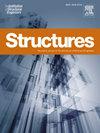全尺寸PEN frp -混凝土-钢双表皮管柱的抗震性能
IF 4.3
2区 工程技术
Q1 ENGINEERING, CIVIL
引用次数: 0
摘要
本文首次对聚萘二甲酸乙二醇酯(PEN)玻璃钢管双层皮管柱(DSTCs)的抗震性能进行了试验研究。纤维增强聚合物(FRP)-混凝土-钢DSTC是一种新型的组合结构。DSTC结构为外FRP管内钢管,用混凝土填充外FRP管和内钢管。DSTCs限制了钢管的向外屈曲,具有优良的抗震性能。已有研究表明,玻璃钢(GFRP)断裂控制了玻璃钢管DSTCs的最终破坏。因此,FRP管的断裂应变是造成DSTCs的关键因素。大断裂应变(LRS) frp的断裂应变大于5 %,这使DSTCs具有优势。本文对6个全尺寸DSTCs进行了试验,研究了FRP类型、PEN FRP厚度、轴压比以及塑性铰区填充混凝土对DSTCs抗震性能的影响。试验结果表明,采用PEN FRP的DSTCs抗震性能等于或略优于GFRP,耗能能力提高41.7% %。降低轴压比、增加PEN FRP厚度、在塑性铰区填充混凝土等措施均可适当提高DSTC抗震性能。本文章由计算机程序翻译,如有差异,请以英文原文为准。
Seismic behavior of full-scale PEN FRP-concrete-steel double skin tubular columns
This paper presents the first experimental study of the seismic performance of double-skin tubular columns (DSTCs) with polyethylene naphthalate (PEN) FRP tubes. Fiber-reinforced polymer (FRP)-concrete-steel DSTC represents a new type of combined structure. A DSTC has an external FRP tube with an internal steel tube, and concrete fills the gap between the two tubes. DSTCs limit the outward buckling of their steel tubes and have excellent seismic performance. Previous studies have shown that glass FRP (GFRP) fracture controls the ultimate failure of DSTCs with a GFRP tube. Therefore, the fracture strain of the FRP tube is a critical factor for DSTCs. The fracture strain of large-rupture-strain (LRS) FRPs is greater than 5 %, which gives DSTCs an advantage. Six full-scale DSTCs were tested in the paper to investigate the effects of FRP type, PEN FRP thickness and the axial compression ratio as well as the plastic hinge region is filled with concrete on the seismic performance of DSTCs. The experimental results indicate that the seismic performance of DSTCs with PEN FRP is equal to or slightly better than that of GFRP, and the energy dissipation capacity improved by 41.7 %. In addition, decreasing the axial compression ratio, increasing the thickness of PEN FRP, and filling the plastic hinge region with concrete appropriately increased the DSTC seismic performance.
求助全文
通过发布文献求助,成功后即可免费获取论文全文。
去求助
来源期刊

Structures
Engineering-Architecture
CiteScore
5.70
自引率
17.10%
发文量
1187
期刊介绍:
Structures aims to publish internationally-leading research across the full breadth of structural engineering. Papers for Structures are particularly welcome in which high-quality research will benefit from wide readership of academics and practitioners such that not only high citation rates but also tangible industrial-related pathways to impact are achieved.
 求助内容:
求助内容: 应助结果提醒方式:
应助结果提醒方式:


